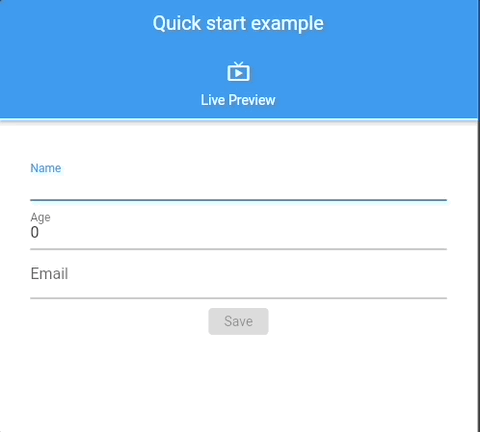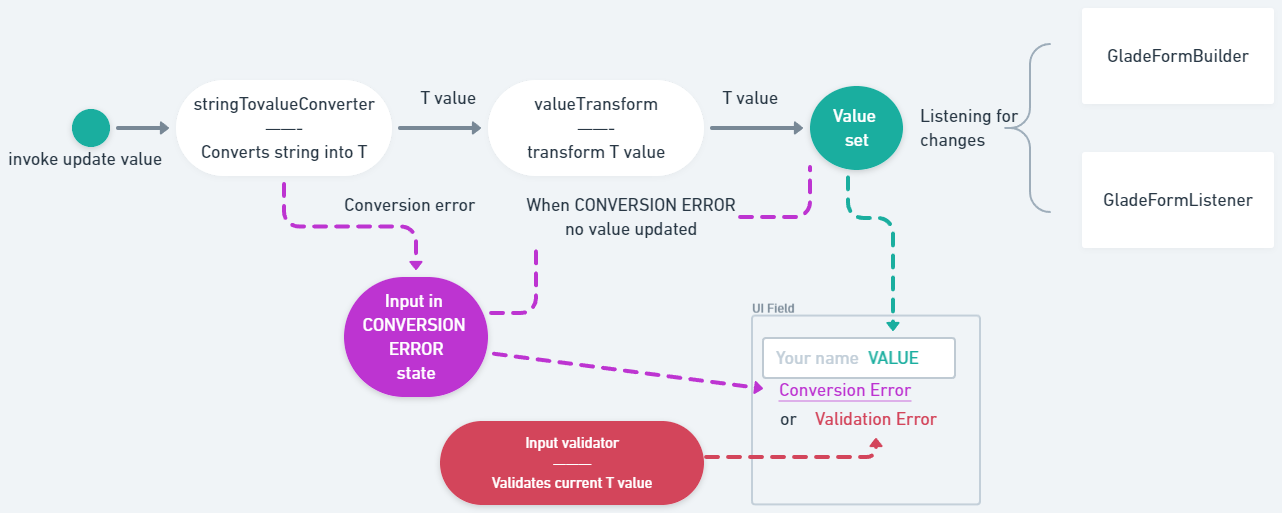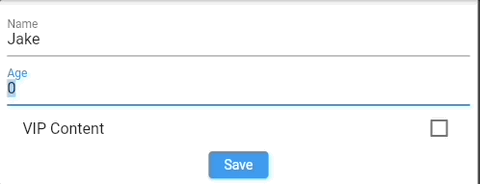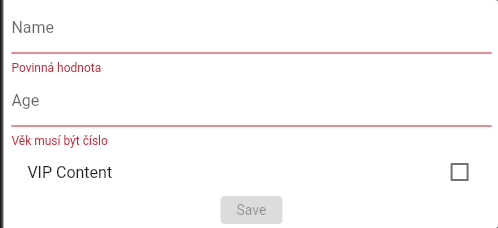
Developed with 💚 by netglade
A universal way to define form validators with support of translations.
Glade Forms offer unified way to define reusable form inputs with support of fluent API to define input's validators and with support of translation on top of that.
Mannaging forms in Flutter is... hard. With Glade Forms you create a model that holds glade inputs, setup validation, translation, dependencies, handling of updates, and more with ease.
To start, setup a Model class that holds glade inputs together.
class _Model extends GladeModel {
late GladeInput<String> name;
late GladeInput<int> age;
late GladeInput<String> email;
@override
List<GladeInput<Object?>> get inputs => [name, age, email];
@override
void initialize() {
name = GladeInput.stringInput();
age = GladeInput.intInput(value: 0, useTextEditingController: true);
email = GladeInput.stringInput(validator: (validator) => (validator..isEmail()).build());
super.initialize();
}
}Then use GladeFormBuilder
and connect the model to standard Flutter form and it's inputs like this:
GladeFormBuilder(
create: (context) => _Model(),
builder: (context, model) => Form(
autovalidateMode: AutovalidateMode.onUserInteraction,
child: Column(
children: [
TextFormField(
decoration: const InputDecoration(labelText: 'Name'),
// connect a controller from glade input
controller: model.name.controller,
// connect a validator from glade input
validator: model.name.textFormFieldInputValidator,
),
TextFormField(
controller: model.age.controller,
validator: model.age.textFormFieldInputValidator,
decoration: const InputDecoration(labelText: 'Age'),
),
TextFormField(
controller: model.email.controller,
validator: model.email.textFormFieldInputValidator,
decoration: const InputDecoration(labelText: 'Email'),
),
const SizedBox(height: 10),
ElevatedButton(onPressed: model.isValid ? () {} : null, child: const Text('Save')),
],
),
),
)Interactive examples can be found in 📖 Glade Forms Widgetbook.
Each form's input is represented by instance of GladeInput<T> where T is value held by input.
For simplicity we will interchange input and GladeInput<T>.
Every input is dirty or pure based on whether value was updated (or not, yet).
On each input we can define
- inputKey - Unique identification of each input. Used inside listeners or in dependencies.
- value - Current input's value
- initialValue - Initial input's value. Used with valueComparator and for computing
isUnchanged. - validator - Input's value must satisfy validation to be valid input.
- translateError - If there are validation errors, this function is use to translate those errors.
- dependencies (WIP) - Each input can depend on another inputs for listening changes.
- stringToValueConverter - If input is used by TextField and
Tis not aString, value converter should be provided. - valueComparator - Sometimes it is handy to provide
initialValuewhich will be never updated after input is mutated.valueComparatorshould be provided to compareinitialValueandvalueifTis not comparable type by default. Note that GladeForms handle deep equality of collections and assumes that complex types are comparable by values. - valueTransform - transform
Tvalue into differentTvalue. An example of usage can be sanitazation of string input (trim(),...). - defaultTranslation - If error's translations are simple, the default translation settings can be set instead of custom
translateErrormethod. - textEditingController - It is possible to provide custom instance of controller instead of default one.
- trackUnchanged - Setting this to false means that
GladeModelwill not include input in theisUnchangedproperty evaluation.
Most of the time, input is created with .create() factory with defined validation, translation and other properties.
An overview how each input's value is updated. If needed it is converted from string into T, then transformed via valueTransform (if provided), after that new value is set.
NOTE: Prior to GladeForms 2.0, each input generated its own TextEditingController and updated this controller whenever the value changed. This approach led to inconsistencies and problems with text-to-speech features, text selection, and other functionalities.
With the introduction of GladeForms 2.0, inputs by default (excluding the StringInput variant), do not create a TextEditingController. As a result, developers are required to use updateValue(), updateValueWithString() or directly set the value (via setter) to update the input's value.
If your implementation involves an input paired with a TextField (or any similar widget that utilizes a TextEditingController), you should set useTextEditingController to true.
Activating the useTextEditingController mode for a GladeInput results in a few behavioral modifications:
- The input automatically creates a TextEditingController and incorporates its own listener.
- Whenever TextEditingController's text changes, input will automatically update its value. If StringConverter is needed it will use it.
- Consequently, developers are advised to provide only the controller property and a validator to the widget.
- While the use of updateValue (or similar methods) and resetToPure remains possible, be aware that these actions will override the text in the controller and reset text selection and other keyboard-related features.
StringInput is specialized variant of GladeInput which has additional, string related, validations such as isEmail, isUrl, maxLength and more.
Moreover StringInput by default uses TextEditingController under the hood.
IntInput is specialized variant of GladeInput which has additional, int related, validations such as isBetween, isMin, isMax and more.
isBetween- checks if value is between min and max value. It has optional parameterinclusiveIntervalwhich defines if min and max values are included in range.isMin- checks if value is greater or equal to min value.isMax- checks if value is less or equal to max value.
Moreover IntInput by default uses TextEditingController under the hood.
final validator = (IntValidator()..isMax(max: 10)).build();
final result = validator.validate(5); // validValidation is defined through part methods on ValidatorFactory such as notNull(), satisfy() and other parts.
Each validation rule defines
- value validation, e.g
notNull()defines that value can not be null.satisfy()defines a predicate which has to be true to be valid etc. - devErrorMessage - a message which will be displayed if no translation is not provided.
- key - Validation error's identification. Usable for translation.
This example defines validation that int value has to be greater or equal to 18.
ageInput = GladeInput.create(
validator: (v) => (v
..notNull()
..satisfy(
(value) => value >= 18,
devError: (_, __) => 'Value must be greater or equal to 18',
key: _ErrorKeys.ageRestriction,
))
.build(),
value: 0,
valueConverter: GladeTypeConverters.intConverter,
);The order of each validation part matters. By default, the first failing part stops validation. Pass stopOnFirstError: false on .build() to validate all parts simultaneously.
Fields connected with textFormFieldInputValidator will automatically call validator and validation error (if any) is passed down to fields. By default devError is used unless translation is specified. See below.
To conditionally skip specific validations, use the shouldValidate callback. If an input should be entirely excluded from validation, consider using conditional logic in the inputs getter.
(v
..minLength(length: 2, shouldValidate: (_) => false)
..maxLength(length: 6))
.build();
// Omit input from validation if the condition applies
get inputs => [if (condition) input];This ensures that the minLength validation is always skipped, while the maxLength validation is applied.
If the condition is met, the input is included in the validation process.
It is possible to use GladeValidator without associated GladeInput.
Just create instance of GladeValidator (or StringValidator) and use it.
final validator = (StringValidator()..notEmpty()).build();
final result = validator.validate(null);GladeModel is base class for Form's model which holds all inputs together. It is useful for cases where you want to sum up validations at once, like disabling save button until all inputs are valid.
GladeModel is ChangeNotifier so all dependant widgets will be rebuilt.
There are several rules how to define models
- Each input has to be mutable and
latefield - Model has to override
initializemethod where each input field is created - In the end of
initializemethod,super.initialize()must be called to wire-up inputs with model.- super.initialize() iterates over all
allInputsproperty (see below) to wire-up inputs with model.
- super.initialize() iterates over all
For updating input call either updateValueWithString(String?) to update T value with string (will be converted if needed) or set value directly (via setter).
Each GladeModel is comprised of a variety of inputs. There are situations where it's useful to dynamically include or exclude certain inputs from the model. This is especially relevant when an input isn't constantly visible, hence not requiring validation, and more importantly, when it shouldn't be factored into GladeModel's validation and other computational processes.
In that case override allInputs getter to list all inputs within GladeModel. Use inputs getter for dynamic behavior. By default allInputs equals to inputs.
isValid or formattedErrors will not work.
GladeForms comes with set of predefined widget to help you build your forms.
GladeModelProvider provides GladeModel to widget's subtreee.
GladeFormBuilder allows to listen to model's changes and rebuilts its child.
GladeFormListener allows to listen to model's changes and react to it. Useful for invoking side-effects such as showing dialogs, snackbars etc. listener provides lastUpdatedKeys which is list of last updated input keys.
GladeFormConsumer combines GladeFormBuilder and GladeFormListener together.
With each update of input, via update or setting .value directly, listeners (if any) are triggered. Sometimes it is needed to edit multiple inputs at once and triggering listener in the end.
For editing multiple values use groupEdit(). It takes void callback to update inputs.
An example
class FormModel extends GladeModel {
late GladeInput<int> age;
late GladeInput<String> name;
// ....
groupEdit(() {
age.value = 18;
name.value = 'default john',
});
}
After that listener will contain lastUpdatedKeys with keys of age and name inputs.
An input can depend on other inputs to enable updates based on those dependencies. To define these dependencies, use the dependencies attribute. It's essential to specify inputKey on any inputs that are intended to serve as dependencies.
For instance, consider a scenario where we want the "VIP Content" option to be automatically selected when the 'ageInput' is updated and its value exceeds 18.
ageInput = GladeInput.create(
value: 0,
valueConverter: GladeTypeConverters.intConverter,
inputKey: 'age-input',
);
vipInput = GladeInput.create(
inputKey: 'vip-input',
dependencies: () => [ageInput],
onDependencyChange: (keys) {
if (keys.contains('age-input')) {
vipInput.value = ageInput.value >= 18;
}
},
);Sometimes, it can be handy to update some input's value based on the changed value of another input. As developer you have two options.
You can listen for onChange() callback and update other inputs based on input's changed value. An example could be automatically updating the Age value based on checked VIP Content input (checkbox).
// In vipContent input
onChange: (info, dependencies) {
if (info.value && ageInput.value < 18) {
ageInput.value = 18;
}
}The second approach is to use dependencies and onDependencyChange callback and react when different dependencies are changed. Note that it works with groupEdit() as well. In that case, onDependencyChange is called once for every changed dependency.
In this example, when age-input update its value (dependency), checkbox's value (vipInput) is updated.
vipInput = GladeInput.create(
inputKey: 'vip-input',
dependencies: () => [ageInput],
onChange: (info) {
if (info.value && ageInput.value < 18) {
ageInput.value = 18;
}
},
onDependencyChange: (key) {
if (key.contains('age-input')) {
vipInput.value = ageInput.value >= 18;
}
},
);Each validation error (and conversion error if any) can be translated. Provide translateError function which accepts:
error- Error to translatekey- Error's identification if anydevMessage- ProvideddevErrorfrom validatordependencies- Input's dependencies
Age example translation (LocaleKeys are generated translations from easy_localization package)
translateError: (error, key, devMessage, {required dependencies}) {
if (key == _ErrorKeys.ageRestriction) return LocaleKeys.ageRestriction_under18.tr();
if (error.isConversionError) return LocaleKeys.ageRestriction_ageFormat.tr();
return devMessage;
}Predefined validators and GladeInput variants defines error keys. Those keys can be found in GladeErrorKeys as static constants. Use them within your translation function or in defualtTranslation.
Use defaultTranslation to provide default translations for common error such as nullValue or emptyValue.
Or use defaultErrorTranslate on model's level.
Order of translation is as follows:
translateError -> defaultTranslation -> `Model.defaultErrorTranslate` -> `error.devMessage` As noted before, if T is not a String, a converter from String to T has to be provided.
GladeForms provides some predefined converters such as IntConverter and more. See GladeTypeConverters for more.
There are some getters and methods on GladeInput / GladeModel which can be used for debugging.
Use model.formattedValidationErrorsDebug to get all input's error formatted for simple debugging.
There is also GladeModelDebugInfo widget which displays table of all model's inputs
and their properties such as isValid, validation error or current value. Widget is customizable, see its properties for more info.
Your contributions are always welcome! Feel free to open pull request.









